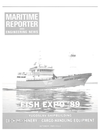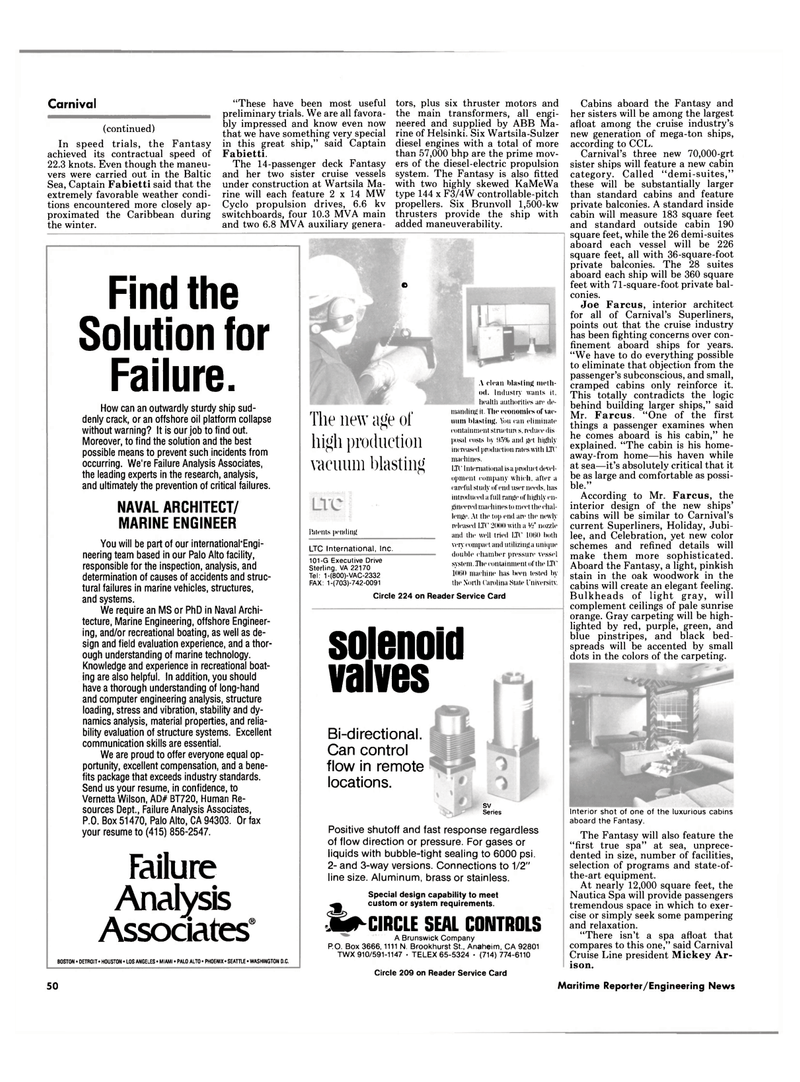
Page 50: of Maritime Reporter Magazine (October 1989)
Read this page in Pdf, Flash or Html5 edition of October 1989 Maritime Reporter Magazine
Carnival (continued)
In speed trials, the Fantasy achieved its contractual speed of 22.3 knots. Even though the maneu- vers were carried out in the Baltic
Sea, Captain Fabietti said that the extremely favorable weather condi- tions encountered more closely ap- proximated the Caribbean during the winter. "These have been most useful preliminary trials. We are all favora- bly impressed and know even now that we have something very special in this great ship," said Captain
Fabietti.
The 14-passenger deck Fantasy and her two sister cruise vessels under construction at Wartsila Ma- rine will each feature 2 x 14 MW
Cyclo propulsion drives, 6.6 kv switchboards, four 10.3 MVA main and two 6.8 MVA auxiliary genera- tors, plus six thruster motors and the main transformers, all engi- neered and supplied by ABB Ma- rine of Helsinki. Six Wartsila-Sulzer diesel engines with a total of more than 57,000 bhp are the prime mov- ers of the diesel-electric propulsion system. The Fantasy is also fitted with two highly skewed KaMeWa type 144 x F3/4W controllable-pitch propellers. Six Brunvoll 1,500-kw thrusters provide the ship with added maneuverability. c
Cabins aboard the Fantasy and her sisters will be among the largest afloat among the cruise industry's new generation of mega-ton ships, according to CCL.
Carnival's three new 70,000-grt sister ships will feature a new cabin category. Called "demi-suites," these will be substantially larger than standard cabins and feature private balconies. A standard inside cabin will measure 183 square feet and standard outside cabin 190 square feet, while the 26 demi-suites aboard each vessel will be 226 square feet, all with 36-square-foot private balconies. The 28 suites aboard each ship will be 360 square feet with 71-square-foot private bal- conies.
Joe Farcus, interior architect for all of Carnival's Superliners, points out that the cruise industry has been fighting concerns over con- finement aboard ships for years. "We have to do everything possible to eliminate that objection from the passenger's subconscious, and small, cramped cabins only reinforce it.
This totally contradicts the logic behind building larger ships," said
Mr. Farcus. "One of the first things a passenger examines when he comes aboard is his cabin," he explained. "The cabin is his home- away-from home—his haven while at sea—it's absolutely critical that it be as large and comfortable as possi- ble."
According to Mr. Farcus, the interior design of the new ships' cabins will be similar to Carnival's current Superliners, Holiday, Jubi- lee, and Celebration, yet new color schemes and refined details will make them more sophisticated.
Aboard the Fantasy, a light, pinkish stain in the oak woodwork in the cabins will create an elegant feeling.
Bulkheads of light gray, will complement ceilings of pale sunrise orange. Gray carpeting will be high- lighted by red, purple, green, and blue pinstripes, and black bed- spreads will be accented by small dots in the colors of the carpeting.
Interior shot of one of the luxurious cabins aboard the Fantasy.
The Fantasy will also feature the "first true spa" at sea, unprece- dented in size, number of facilities, selection of programs and state-of- the-art equipment.
At nearly 12,000 square feet, the
Nautica Spa will provide passengers tremendous space in which to exer- cise or simply seek some pampering and relaxation. "There isn't a spa afloat that compares to this one," said Carnival
Cruise Line president Mickey Ar- ison.
Find the
Solution for
Failure.
How can an outwardly sturdy ship sud- denly crack, or an offshore oil platform collapse without warning? It is our job to find out.
Moreover, to find the solution and the best possible means to prevent such incidents from occurring. We're Failure Analysis Associates, the leading experts in the research, analysis, and ultimately the prevention of critical failures.
NAVAL ARCHITECT/
MARINE ENGINEER
You will be part of our international'Engi- neering team based in our Palo Alto facility, responsible for the inspection, analysis, and determination of causes of accidents and struc- tural failures in marine vehicles, structures, and systems.
We require an MS or PhD in Naval Archi- tecture, Marine Engineering, offshore Engineer- ing, and/or recreational boating, as well as de- sign and field evaluation experience, and a thor- ough understanding of marine technology.
Knowledge and experience in recreational boat- ing are also helpful. In addition, you should have a thorough understanding of long-hand and computer engineering analysis, structure loading, stress and vibration, stability and dy- namics analysis, material properties, and relia- bility evaluation of structure systems. Excellent communication skills are essential.
We are proud to offer everyone equal op- portunity, excellent compensation, and a bene- fits package that exceeds industry standards.
Send us your resume, in confidence, to
Vernetta Wilson, AD# BT720, Human Re- sources Dept., Failure Analysis Associates,
P.O. Box 51470, Palo Alto, CA 94303. Or fax your resume to (415) 856-2547.
Failure Analysis
Associates®
BOSTON • DETROIT • HOUSTON • LOS ANGELES - MIAMI • PALO ALTO • PHOENIX • SEATTLE • WASHINGTON D.C.
The new age of high production vacuum blasting
Ritents pending
LTC International, Inc. 101-G Executive Drive
Sterling, VA 22170
Tel: 1-(800)-VAC-2332
FAX: 1-(703)-742-0091
A clean blasting meth- od. Industry wants it. health authorities are de- manding it. The economics of vac- uum blasting. You can eliminate containment structure s, reduce (lis posal costs by 95% and get highly increased production rates with LTC machines.
LTC International isa product devel- opment company which, after a careful study of end user needs, lias introduced a full range of highly en- gineered machines to meet the chal- lenge. At the top end are the newly released LTC 2000 with a W nozzle and the well tried LTC 1060 both very compact and utilizing a unique double chamber pressure vessel system. The containment of the LTC 1060 machine has been tested by the North Carolina State University.
Circle 224 on Reader Service Card solenoid valves
Bi-directional.
Can control flow in remote locations. sv
Series
Positive shutoff and fast response regardless of flow direction or pressure. For gases or liquids with bubble-tight sealing to 6000 psi. 2- and 3-way versions. Connections to 1/2" line size. Aluminum, brass or stainless.
Special design capability to meet ^ custom or system requirements. •XrCIRCLE SEAL CONTROLS
A Brunswick Company
P.O. Box 3666,1111 N. Brookhurst St., Anaheim, CA 92801
TWX 910/591-1147 • TELEX 65-5324 • (714) 774-6110
Circle 209 on Reader Service Card 50 Maritime Reporter/Engineering News

 49
49

 51
51
